Conic Section¶
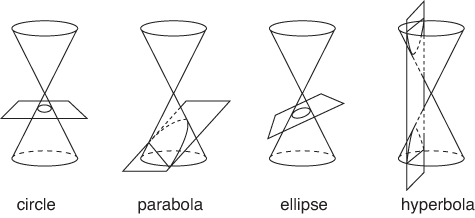
Cone & its Sections¶
- Right Circular Cone: The surface generated when one straight line that intersects another fixed straight line is rotated at an oblique angle. The lines are called generators of the cone.
- Axis of the Cone: The fixed line of the cone is called its axis.
- Elements of the Cone: The possible positions of the generating line in its rotation about the axis are its elements.
- Vertex: The common intersection point of all the cone's elements is called Vertex of cone.
- Napes: The two symmetrical parts of the generated surface on each side of the vertex are cone's Napes.
- Conic Sections or Conics: The curves that can be obtained by cutting a cone with a plane are called conic sections or conics.
- Circle: When the intersecting plane cuts completely across one napes at right angle to the axis of cone, the curve is called circle.
- Point Circle: If the intersection plane cuts across the vertex of a cone, the resulting curve is called point circle.
- Parabola: When the intersecting plane is parallel to an element, an passing through only one nape, the resulting curve is Parabola.
- Ellipse: When the intersecting plane cuts completely across one nape at an oblique angle to the axis, the curve is an ellipse.
- Hyperbola: When the intersecting plane cuts through both napes parallel to the axis of the cone the resulting curve is hyperbola.
Circle¶
A set of points such that distance of each point fixed point called center remains constant. The constant distance is called radius of the circle.
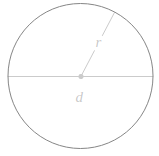
Equation¶
- Standard Equation
When center is \((h,k)\) & radius is \(r\): $$ (x-h)^2 + (y-k)2 = r2 $$
When center is \((0,0)\) & radius is \(r\): $$ x^2 + y2 = r2 $$ - Parametric Equation \[ x= r\cos\theta \] \[ y= r\sin\theta \]
- If end points of the diameter of circle are \(a(x_,y_1)\), \(B(x_2,y_2)\) $$ (x-x_1)(x-x_2)+(y-y_1)(y-y_2)=0 $$
- General Form $$ x^2 + y^2 + 2gx+2fy+c=0 $$ The general form of circle equation have following properties:
- It involves three constants \(f,g,c\)
- It is a second degree equation in which coefficients of \(x^2\) & \(y^2\) are \(1\)
- It does not involves \(xy\) product
- Center of the circle is \((-g,-f)\)
- Radius of circle is \(\sqrt{g^2+f^2-c}\). If:
- \(r=\sqrt{g^2+f^2-c}>0\) circle is real circle
- \(r=\sqrt{g^2+f^2-c}=0\) circle is point circle
- \(r=\sqrt{g^2+f^2-c}<0\) circle is imaginary circle
Properties¶
- Perpendicular dropped from the center of a circle on a chord bisects the cord.
- The perpendicular bisector of any chord of a circle passes through the center of the circle.
- The line joining the center of a circle to the midpoint of chord is perpendicular to the chord.
- Congruent chords of a circle are equidistant from its center.
- Measure of the central angle of a minor arc is double the measure of the angle subtended in the corresponding major arc.
- An angle is a semi-circle is a right angle.
- The tangent to a circle at any point of the circle is perpendicular to the radial segment at that point.
- The perpendicular at the outer end of a radial segment is tangent to the circle.
- Normal lines of a circle pass through the center of the circle.
- Mid point of the hypotenuse of a right triangle is the circum-center of the triangle.
- Perpendicular dropped from a point of a circle on diameter is a mean proportional between the segments into which it divides the diameter.
Theorems¶
- the point \(P(x_1,y_2)\), on circle \(x^2+y^2+2gx+2fy+c=0\) lies:
- outside circle if \(x_1^2+y_1^2+2gx+2fy+c>0\)
- on circle if \(x_1^2+y_1^2+2gx+2fy+c=0\)
- inside circle if \(x_1^2+y_1^2+2gx+2fy+c<0\)
- Any two tangents can be drawn to a circle from any point outside the circle.
- Let \(P(x_1,y_1)\) be a point outside the circle \(x^2+y^2+2gx+2fy+c=0\), then length of either tangents drawn to circle is : $$ \sqrt{x_1^2 +y_1^2 +2gx_1 +2fy_1 + c} $$
- The line \(y=mx+c\) intersects the circle \(x^2+y^2=a^2\) in at the most two points, the points are:
- Real & distinct if \(a^2(1+m^2)>c^2\)
- Real & coincident if \(a^2(1+m^2)=c^2\) (also called condition of tangency)
- Imaginary if \(a^2(1+m^2)<c^2\)
Contact of two Circles¶
Let \(r_1\), \(r_2\) be the radii of two circles with \(C_1\) & \(C_2\) be their centers, then:
- Circles touches externally if \(|C_1C_2|=r_1+r_2\)
- Circles touches internally if \(|C_1C_2|=|r_1-r_2|\)
- Circles intersect in two real distinct points if \(|r_1-r_1|<|C_1C_2|<(r_1+r_2)\)
- Circle don't touches each other if \(|r_1-r_2|>|C_1C_2|>r_1+r_2\)
Tangent¶
A straight line that touches the curve at a single point without cutting the curve is called tangent. It is perpendicular to the line segment joining center to that point.
Equation¶
- Equation of tangent to the circle \(x^2+y^2=a^2\) at \(P(x_1,y_1)\): $$ xx_1+ yy_1=a^2 $$
- Equation of tangent to the circle \(x^2+y^2 +2gx+2fy+c=0\) at \(P(x_1,y_1)\): $$ xx_1+ yy_1 + g(x+x_1)+ f(y+y_1)+c=0 $$
Normal¶
A straight line perpendicular to the curve at point of tangency.
Equation¶
- Equation of normal to the circle \(x^2+y^2=a^2\) at \(P(x_1,y_1)\): $$ xx_1- yy_1=0 $$
- Equation of tangent to the circle \(x^2+y^2 +2gx+2fy+c=0\) at \(P(x_1,y_1)\): $$ (x-x_1)(y_1+f) + (y-y_1)(x_1+g)=0 $$
Parabola¶
A set of points in a plane such that the distance of each point form a fixed point (focus), equal to its distance from a fixed straight line (directrix, L)
Equation¶
- Standard Form of standard parabola: $$ y^2=4ax $$
- Parametric Equation: $$ x=at^2 $$ $$ y=2at $$
- General form: $$ ax^2 +by^2 +2gx+2fy+c=0 $$ Its a second degree equation in which either \(a=0\) or \(b=0\) but not both.
Terms¶
- Axis of Parabola: The line through focus and perpendicular to directrix is called axis of parabola.
- Vertex: The mid point of the perpendicular line joining focus and directrix is called vertex of parabola.
- Focal Chord: A chord of the parabola through focus is called focal chord.
- Latusrectum: The focal chord perpendicular to the axis of the parabola is called latusrectum of the parabola.
- Eccentricity: The ratio of the distance of any point on the parabola to its distance from directrix.
Summary of Standard Parabolas¶
| # | 1 | 2 | 3 | 4 |
|---|---|---|---|---|
| Equation | \(y^2=4ax\) | \(y^2=-4ax\) | \(x^2=4ay\) | \(x^2=-4ay\) |
| Focus | \((a,0)\) | \((-a,0)\) | \((0,a)\) | \((0,-a)\) |
| Vertex | \((0,0)\) | \((0,0)\) | \((0,0)\) | \((0,0)\) |
| Length of Latusrectum | \(4a\) | \(4a\) | \(4a\) | \(4a\) |
| Equation of Latusrectum | \(x=a\) | \(x=-a\) | \(y=a\) | \(y=-a\) |
| Equation of Directrix | \(x=-a\) | \(x=a\) | \(y=-a\) | \(y=a\) |
| Axis | \(y=0\) | \(y=0\) | \(x=0\) | \(x=0\) |
| Eccentricity | \(1\) | \(1\) | \(1\) | \(1\) |
| Graph | 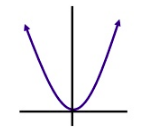 |
 |
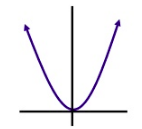 |
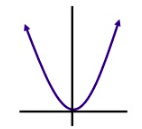 |
Theorems on Parabola¶
- The point on the parabola closest to the focus is the vertex.
- The ordinate at any point \(P\) of the parabola is a mean proportional between the length of the latusrectum and the abscissa of \(P\).
- The tangent at any point \(P\) of a parabola makes equal angles with the line \(PF\) and the line through \(P\) parallel to the axis of parabola, \(F\) being focus.
Ellipse¶
A set of point such that the distance of each from fixed point (focus, \(F\)) bears a constant ration (Eccentricity, \(0<e<1\)) to its perpendicular distance from a fixed straight line (directrix, \(L\)).
Terms¶
- Vertices: The points on the standard ellipse where it crosses the x-aix.
- Co-vertices: The points on the standard ellipse where it crosses the y-axis.
- Center: The midpoint of the line joining vertices
- Major axis: The lines joining vertices is called major axis.
- Minor axis: The line joining co-vertices is called minor axis.
- Latusrectum: The cords perpendicular to major axis passed through foci are called latusrectum.
- Eccentricity: The ratio of the distance of any point on the ellipse from the focus to its distance from the directrix.
Summary of Standard Forms of Ellipse¶
| # | 1 | 2 |
|---|---|---|
| Equation | $$ \frac{x^2 }{a^2 } + \frac{y^2 }{b^2 }=1,\;a>b $$ | $$ \frac{y^2 }{a^2 } + \frac{x^2 }{b^2 }=1,\;a>b $$ |
| Foci | \((\pm c,0),c^2=a^2-b^2\) | \((0,\pm c),c^2=a^2-b^2\) |
| Eccentricity | \(0<e=\frac{c}{a}<1\) | \(0<e=\frac{c}{a}<1\) |
| Vertices | \((\pm a,0)\) | \((0,\pm a)\) |
| Co vertices | \((0,\pm b)\) | \((\pm b,0)\) |
| Center | \((0,0)\) | \((0,0)\) |
| Length of Major Axis | \(2a\) | \(2a\) |
| Equation of Major Axis | \(y=0\) | \(x=0\) |
| Length of Major Axis | \(2b\) | \(2b\) |
| Equation of Major Axis | \(x=0\) | \(y=0\) |
| Length of Latusrectum | \({2b^2}/{a}\) | \({2b^2}/{a}\) |
| Equation of Directrix | \(x=\pm{c}/{e^2}\) | \(y\pm{c}/{e^2}\) |
| Graph |  |
 |
Theorems on Ellipse¶
- The sum of the focal distances of any point on an ellipse is equal to length of major axis \(2a\)
- The distance between center and any focus of the ellipse is denoted by \(c\), and is given as \(\sqrt{a^b-b^2}\)
- The distance between foci is \(2c\)
Hyperbola¶
A set of points such that the distance of each point from a fixed point (focus, \(F\)) bears a constant ratio (Eccentricity, \(e>1\)) to its perpendicular distance from a fixed straight line (directrix, \(L\)).
Terms¶
- Vertices: The points on the standard hyperbola where it crosses the x-axis.
- Center: The midpoint of the line joining the vertices or co-vertices.
- Transverse axis: The line joining vertices is called transverse axis.
- Conjugate axis: The line joining co vertices is called conjugate axis.
- Latusrecta: The chords perpendicular to major axis passes through foci are called Latusrecta.
- Eccentricity: The ratio of distance of any point on ellipse from the focus to its distance from directrix,
- Asymptotes: In general, an asymptote is a line approaches to a curve but never touches it.
Every hyperbola has associated with two lines called asymptotes. Their point of intersection is center of hyperbola.- Slope of asymptotes \(=\pm b/a\) (hyperbola opens to sides)
- Slope of asymptotes \(=\pm a/b\) (hyperbola opens to up & down)
Summary of Standard Forms of Hyperbola¶
| # | 1 | 2 |
|---|---|---|
| Equation | $$ \frac{x^2 }{a^2 }-\frac{y^2 }{b^2 }=1 $$ | $$ \frac{y^2 }{a^2 }-\frac{x^2 }{b^2 }=1 $$ |
| Foci | \((\pm c,0),c^2=a^2+b^2\) | \((0, \pm c),c^2=a^2+b^2\) |
| Eccentricity | \(e=c/a>1\) | \(e=c/a>1\) |
| Vertices | \((\pm a,0)\) | \((0,\pm a)\) |